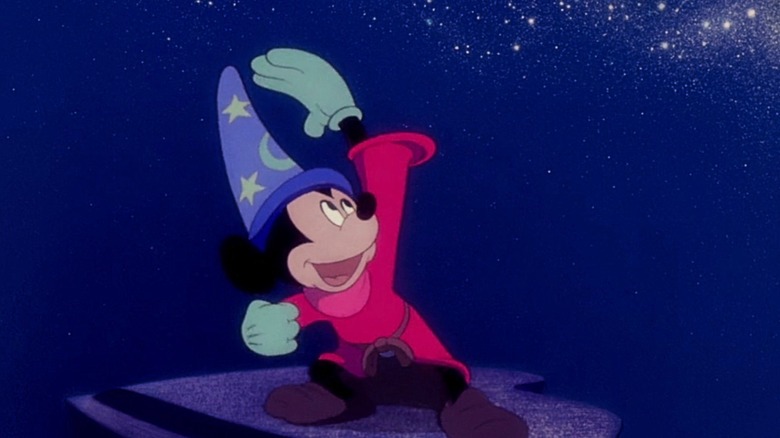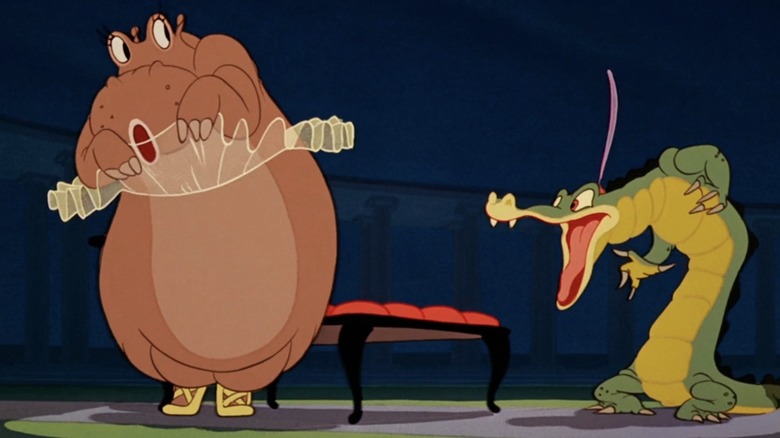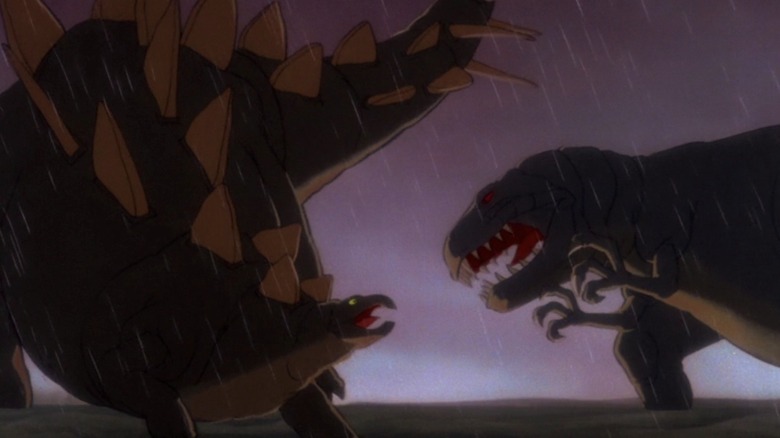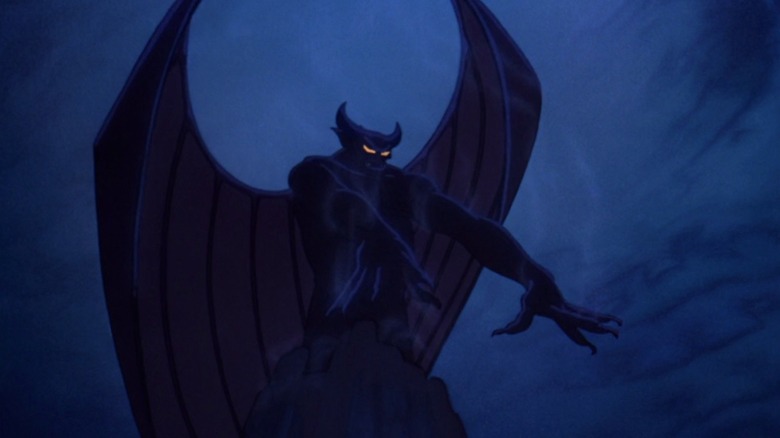The Daily Stream: Fantasia Is Pure Music And Pure Cinema
(Welcome to The Daily Stream, an ongoing series in which the /Film team shares what they've been watching, why it's worth checking out, and where you can stream it.)
The Movie: "Fantasia"
Where You Can Stream It: Disney+
The pitch: "What you're going to see are the designs and pictures and stories that music inspired in the minds and imaginations of a group of artists." This is how Deems Taylor, the live-action MC for "Fantasia," sets up Disney's third classic animated feature.
The most random thing caused me to rewatch "Fantasia" this week for maybe the first time since before the turn-of-the-millennium sequel, "Fantasia 2000," was in theaters. It was when I realized that "Moon Knight" isn't the only Disney+ title with anthropomorphic hippos and crocodilians (dancing alligators theoretically being members of the same taxonomic order as regular gators and crocodiles).
There's a scene in "Moon Knight" where a god controls the stars with his hands, making them swirl in the sky. Most people probably know of "Fantasia" through a similar image of Mickey Mouse as "The Sorcerer's Apprentice," not just wishing upon a star like Pinocchio (who also danced into theaters in 1940), but dreaming so deep that he can change the cosmos.
That image has seeped into theme parks and pop culture awareness, but "The Sorcerer's Apprentice" is only one segment in the experimental musical anthology that is "Fantasia." For years, the actual film and others like it were locked up in the Disney Vault, unavailable on home media. Now, they're sitting right there on Disney+, and some of them, "Fantasia" included, carry a content warning about the "negative depictions and/or mistreatment of people or cultures."
In an age when people can and do adjust the playback speed of movies, watching them faster or skipping ahead through "the boring parts" ten seconds at a time, I wonder how many first-time viewers would have the patience to just sit back, relax, and watch "Fantasia."
Why it's essential viewing
"Fantasia" is one of only three Disney films that made the American Film Institute's list of the 100 greatest American movies of the 20th century, with the other two being "Snow White and the Seven Dwarfs" and (in the updated 21st-century list) "Toy Story." Beyond that, it's in the National Film Registry and is also one of the highest-grossing movies of all time when adjusted for inflation.
The film, overseen by Walt Disney himself, shortly throws down the musical gauntlet, as the live-action shadows of orchestra members against a blue background give way to hand-drawn, almost screensaver-like visuals, which flow to the tune of Bach's Toccata and Fugue in D minor. In 1957, Captain Nemo (James Mason) would play this same piece of music on the organ aboard the Nautilus submarine in Disney's "20,000 Leagues Under the Sea."
The effect, Deems explains, is to segue into the film with "the picture of various abstract images that might pass through your mind if you sat in a concert hall listening to this music." Suffice it to say, "Fantasia" does not follow the conventional Disney narrative patterns. That's what makes it appealing to anyone looking for a change of pace from princesses with animal sidekicks.
There are still plenty of animals in "Fantasia," but they're not the talking kind. In fact, outside interludes with Deem, there's not much talking in "Fantasia" at all.
It reminds me of that Alfred Hitchcock quote: "When the screenplay has been written and the dialogue has been added, we're ready to shoot." Mickey was not so far removed from the silent film era and his own first adventure in "Steamboat Willie," but his popularity had waned since 1928, and "Fantasia" was a kind of quasi-silent comeback for him, like Elvis in Las Vegas but with a broomstick instead of a microphone stand.
Every second's worth 24,000 words
Some of "Fantasia" is outright plotless, but as Deems observes, other parts of it tell "a definite story" using only classical music and the moving image. If a picture is worth a thousand words, and each second of a movie is made up of 24 pictures or frames (in this case, drawings done by hand), then every second of "Fantasia" is worth 24,000 words.
There are no nutcrackers in "The Nutcracker Suite" segment, just dancing faeries, Chinese-coded mushrooms, and flowers and fish. It's followed by the aforementioned "Sorcerer's Apprentice," a brilliant animated short that needs no explanation, though Deems notes how it involves the apprentice "practicing the boss's best magic tricks before learning how to control them."
Mickey shows up with water pails right at the half-hour mark of "Fantasia," and like Victor Frankenstein, he soon learns the consequences of playing God. His white-bearded master even parts the waters, Moses-style, when he comes to bail him out. It's not the only time in "Fantasia" that we'll see a narcoleptic, white-bearded figure exercise his godly powers. If you, too, find the music lulling you to sleep, the great thing about "Fantasia" is that it comes with a built-in intermission, giving the viewer a natural jumping-off point if they need a break or want to split it up over two sittings and watch the second half later.
"The Rite of Spring" plays like an early animated blueprint for Terrence Malick's "The Tree of Life," insofar as it shows "the growth of life on earth" from single-celled organisms to the dinosaurs. Whirlwinds of fire erupt from volcanoes and the planet bubbles over with lava, until the sea and air are teeming with dinos and the stage is set for a T-Rex and Stegosaurus battle—which can still be seen in the animatronic Primeval World Diorama on the Disneyland Railroad. This segment also inspired the dinosaur scenes in Epcot's Universe of Energy, which once occupied the Guardians of the Galaxy: Cosmic Rewind ride building.
A hymn to light the imagination
With its seductive centaurs and bare-bottom cupids, "The Pastoral Symphony" has some weird overtones to it. The Hays Code would not allow the female centaurs to appear topless, and in the 1960s, the segment would be further edited to remove two Black centaurs who were depicted in a stereotypical manner. What's left is a tame bacchanal, which has Bacchus, the Roman wine god himself, in attendance, until the Greek god, Zeus, crashes the party with a game of lightning-bolt darts.
"Dance of the Hours" isn't just tutu-clad hippos and caped alligators. It starts with balletic ostriches and a cornucopia of fruit. The recognizable title tune also featured in the montage of classic movie moments at the end of The Great Movie Ride (which based its penultimate ride scene on "The Sorcerer's Apprentice," too.) It might leave some veteran Disney theme park goers waiting for the transition to "Tara's Theme" from "Gone with the Wind."
"Night on Bald Mountain" gives "Fantasia" its big finish and its title refers to Walpurgis Night and the traditional "gathering place of Satan and his followers." The 1931 film adaptation of "Dracula," starring Bela Lugosi, used this night as a setting, and according to The Los Angeles Times, Lugosi was tested but abandoned as a reference model for the bat-winged Chernabog in "Fantasia."
Skeletal ghost riders and Boschian demons flock to Chernabog's cauldron of fire before church bells signal sunrise and the triumph of the sacred over the profane. "Fantasia" itself could be said to represent that same triumph. As a procession of figures with torches pass through the woods to the tune of the soul-cleansing "Ave Maria," one gets the sense that they are on their way to light the imagination of future generations.



